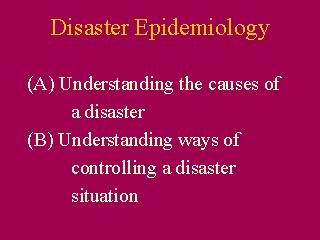|
|
|
|
front
|1
|2
|3
|4
|5
|6
|7
|8
|9
|10
|11
|12
|13
|14
|15
|16
|17
|18
|19
|20
|21
|22
|23
|24
|25
|26
|27
|28
|29
|30
|31
|32
|33
|34
|35
|36
|37
|38
|
 |
The epidemiologic investigation of disaster events focuses on two approaches. The first is the typical epidemiologic study of the underlying causes of the disaster. This may focus upon the event itself, or the mortality and morbidity associated with the
event. Learning as much as possible about the reasons for disasters is important for developing prevention activities in the future.
The second approach is to use epidemiologic methods to investigate mechanisms for alleviating the burden of a disaster once it occurs. This may be applied at the stage of disaster preparedness or at the stage of disaster relief. The most direct applicat ion of epidemiology in this situation is the establishment of surveillance systems to identify injuries and the possible emergence of communicable diseases. |